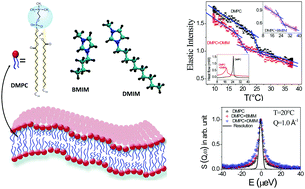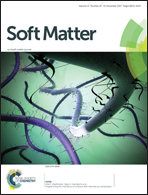Effects of ionic liquids on the nanoscopic dynamics and phase behaviour of a phosphatidylcholine membrane
Abstract
Ionic liquids (ILs) are potential candidates for new antimicrobials due to their tunable antibacterial and antifungal properties that are required to keep pace with the growing challenge of bacterial resistance. To a great extent their antimicrobial actions are related to the interactions of ILs with cell membranes. Here, we report the effects of ILs on the nanoscopic dynamics and phase behaviour of a dimyristoylphosphatidylcholine (DMPC) membrane, a model cell membrane, as studied using neutron scattering techniques. Two prototypical imidazolium-based ILs 1-butyl-3-methylimidazolium tetrafluoroborate (BMIM[BF4]) and 1-decyl-3-methylimidazolium tetrafluoroborate (DMIM[BF4]), which differ only in terms of the alkyl chain length of cations, have been used for the present study. Fixed Elastic Window Scan (FEWS) shows that the incorporation of ILs affects the phase behaviour of the phospholipid membrane significantly and the transition from a solid gel to a fluid phase shifts to lower temperature. This is found to be consistent with our differential scanning calorimetry measurements. DMIM[BF4], which has a longer alkyl chain cation, affects the phase behaviour more strongly in comparison to BMIM[BF4]. The pressure–area isotherms of the DMPC monolayer measured at the air–water interface show that in the presence of ILs, isotherms shift towards higher area-per lipid molecule. DMIM[BF4] is found to shift the isotherm to a greater extent compared to BMIM[BF4]. Quasielastic neutron scattering (QENS) data show that both ILs act as a plasticizer, which enhances the fluidity of the membrane. DMIM[BF4] is found to be a stronger plasticizing agent in comparison to BMIM[BF4] that has a cation with a shorter alkyl chain. The incorporation of DMIM[BF4] enhances not only the long range lateral motion but also the localised internal motion of the lipids. On the other hand, BMIM[BF4] acts weakly in comparison to DMIM[BF4] and mainly alters the localised internal motion of the lipids. Any subtle change in the dynamical properties of the membrane can profoundly affect the stability of the cell. Hence, the dominant effect of the IL with the longer chain length on the dynamics of the phospholipid membrane might be correlated with its cytotoxic activity. QENS data analysis has provided a quantitative description of the effects of the two imidazolium-based ILs on the dynamical and phase behaviour of the model cell membrane, which is essential for a detailed understanding of their action mechanism.



 Please wait while we load your content...
Please wait while we load your content...